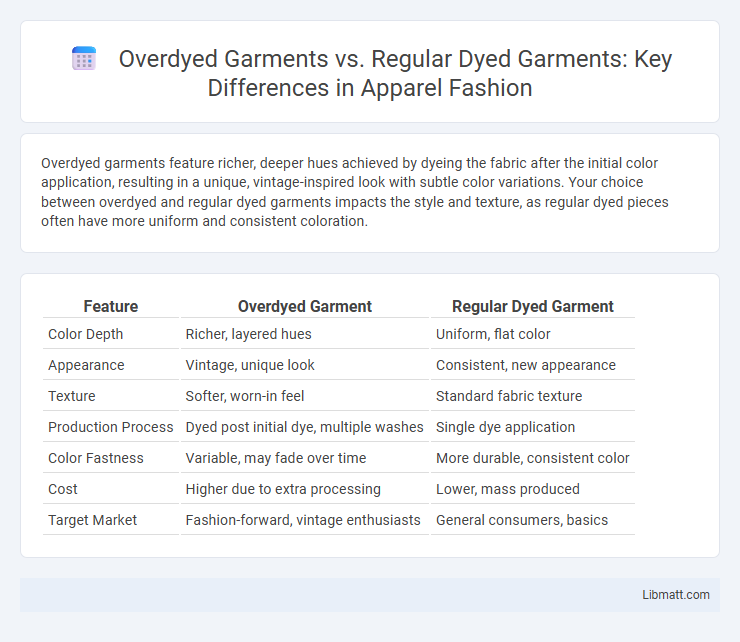Overdyed garments feature richer, deeper hues achieved by dyeing the fabric after the initial color application, resulting in a unique, vintage-inspired look with subtle color variations. Your choice between overdyed and regular dyed garments impacts the style and texture, as regular dyed pieces often have more uniform and consistent coloration.
Table of Comparison
| Feature | Overdyed Garment | Regular Dyed Garment |
|---|---|---|
| Color Depth | Richer, layered hues | Uniform, flat color |
| Appearance | Vintage, unique look | Consistent, new appearance |
| Texture | Softer, worn-in feel | Standard fabric texture |
| Production Process | Dyed post initial dye, multiple washes | Single dye application |
| Color Fastness | Variable, may fade over time | More durable, consistent color |
| Cost | Higher due to extra processing | Lower, mass produced |
| Target Market | Fashion-forward, vintage enthusiasts | General consumers, basics |
Introduction to Garment Dyeing Techniques
Overdyed garments undergo a secondary dyeing process, giving them a rich, layered color effect that enhances fabric texture and depth, compared to regular dyed garments, which receive a uniform single dye application. This overdying technique often results in unique, vintage-inspired tones and subtle color variations due to the interaction between the original fabric color and the new dye. Regular dyeing provides consistent, even coloration ideal for solid-color apparel, while overdying is favored for creating bespoke, artisanal looks in fashion and textile industries.
Defining Overdyed Garments
Overdyed garments undergo a specialized dyeing process where pre-dyed or finished fabrics are dyed again to create unique, rich hues with a vintage or textured appearance. This technique enhances color depth and can produce subtle variations and distressed effects not achievable with regular dyed garments. Regular dyed garments, in contrast, are colored during the initial fabric production, resulting in uniform and consistent coloration without additional layering or texture.
What Are Regular Dyed Garments?
Regular dyed garments undergo a standard dyeing process where fabric is colored uniformly using synthetic or natural dyes before garment assembly. This method ensures consistent color intensity and predictable outcomes across large production batches. Regular dyeing techniques often rely on reactive, direct, or vat dyes to achieve vibrant and long-lasting hues on various textile fibers.
The Overdyeing Process Explained
Overdyeing is a specialized fabric treatment where garments are dyed after their initial coloration, creating a rich, multi-dimensional hue with unique texture variations. This process involves immersing pre-colored garments in a new dye bath, allowing the secondary color to blend seamlessly and enhance the original tone, unlike regular dyed garments that receive color only once during production. Overdyed garments often display a softer feel and a vintage, worn-in aesthetic that distinguishes them from the uniform appearance of regularly dyed fabrics.
Key Differences Between Overdyed and Regular Dyed Garments
Overdyed garments undergo a secondary dyeing process that enhances color richness and creates unique, vintage-like tones, while regular dyed garments are colored in a single, consistent dyeing stage resulting in uniform hues. Overdyeing often produces subtle texture variations and depth, making each piece distinct, whereas regular dyeing emphasizes precise color accuracy and replication. The key difference lies in overdyed fabrics offering a more artisanal, worn-in aesthetic compared to the smooth, even finish of regular dyed textiles.
Visual and Textural Effects of Overdyeing
Overdyed garments showcase a rich, multidimensional color palette with subtle variations and depth that regular dyed garments typically lack. The overdyeing process creates unique textures and a worn-in, vintage appeal by layering colors that interact with the fabric's original hues. Your wardrobe benefits from this distinctive aesthetic, combining visual complexity with a soft, lived-in feel not found in standard dyed clothing.
Durability and Longevity: Overdyed vs. Regular Dyed
Overdyed garments exhibit enhanced durability due to the additional dye layers that reinforce fabric fibers, reducing color fading and wear over time compared to regular dyed garments. The overdying process intensifies colorfastness, resulting in longer-lasting vibrancy even after multiple washes. Regular dyed garments tend to fade more quickly as the dye penetrates less deeply, leading to shorter garment lifespan and diminished aesthetic appeal.
Sustainability and Environmental Impact
Overdyed garments utilize a process that extends the life of reclaimed or vintage fabrics by applying new dye layers, significantly reducing textile waste and minimizing water consumption compared to traditional dyeing methods. Regular dyed garments typically involve fresh fabric production with higher resource input, including greater water use, chemical treatments, and energy consumption, contributing to increased environmental pollution. Choosing overdyed garments supports circular fashion initiatives by lowering carbon footprints and promoting sustainable manufacturing practices in the apparel industry.
Fashion Trends: Why Choose Overdyed Garments?
Overdyed garments offer unique, vibrant color variations that align with current fashion trends seeking individuality and sustainability. Unlike regular dyed garments with uniform color, overdyed pieces showcase depth and texture, making your wardrobe stand out with an artisanal touch. Choosing overdyed garments supports eco-friendly practices by repurposing existing fabrics, appealing to consumers prioritizing ethical fashion.
Choosing the Right Dyeing Method for Your Wardrobe
Overdyed garments offer a richer, more textured color effect by applying dye over previously dyed fabric, creating a unique, vintage-inspired appearance that evolves with wear. Regular dyed garments involve a uniform dyeing process that ensures consistent, vibrant color, ideal for a polished and predictable look in your wardrobe. Selecting the right method depends on whether you prefer personalized, characterful pieces (overdyed) or classic, even tones (regular dyed) to complement your style.
Overdyed Garment vs Regular Dyed Garment Infographic

 libmatt.com
libmatt.com